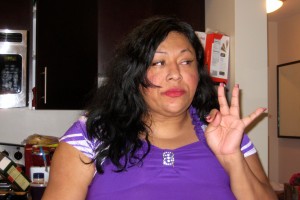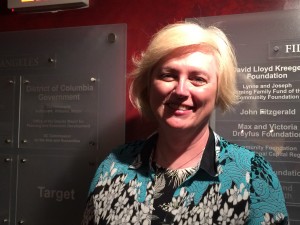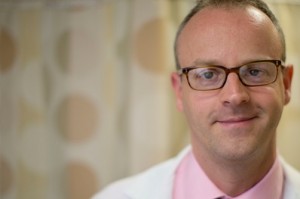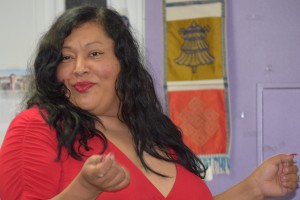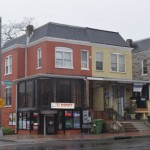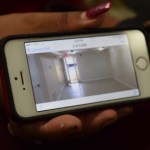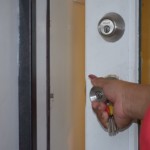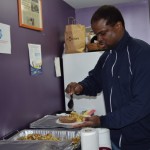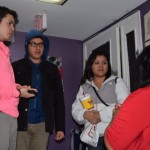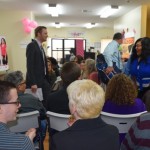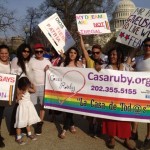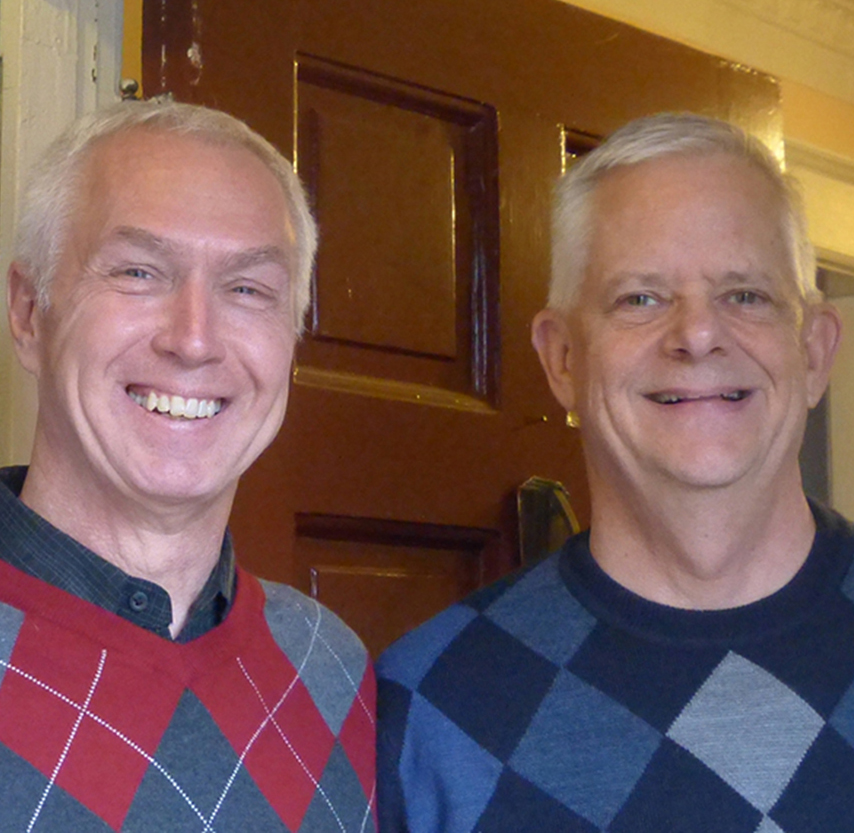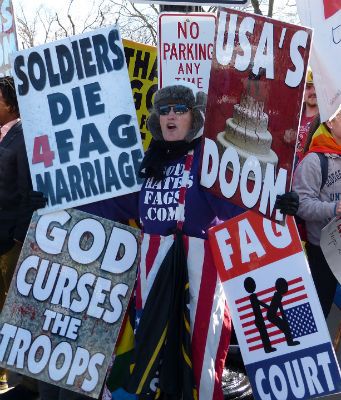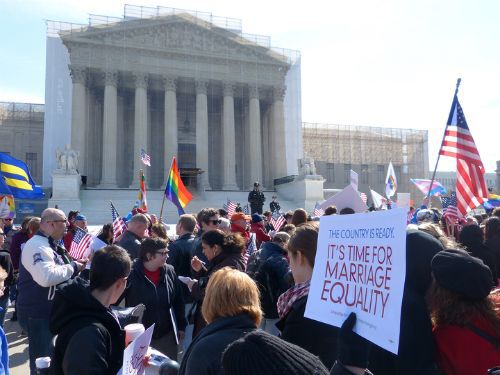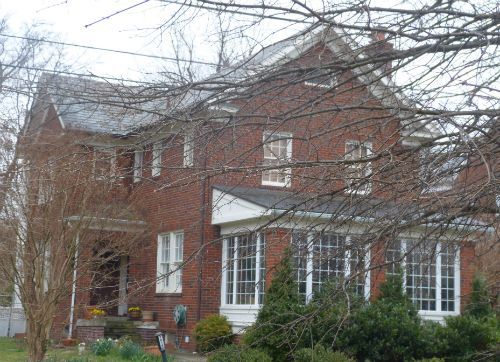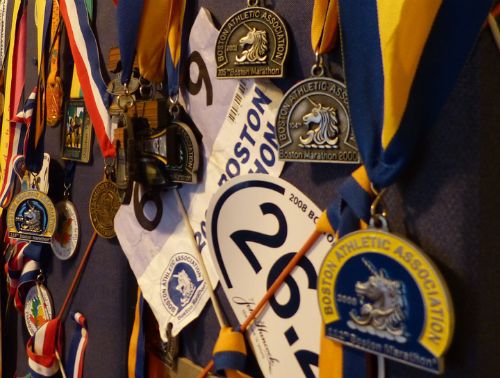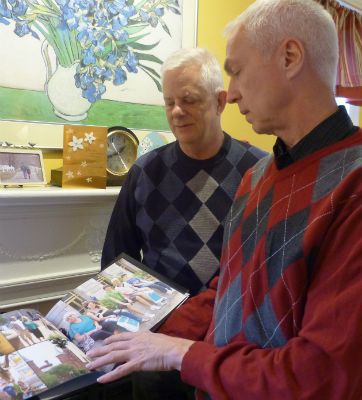Sparkling Ruby
Ruby Corado loves gifts, especially sparkly ones.
Tony, her lover, had promised her a gift that winter night. Corado remembers that in anticipation of the gift, she wanted to look spectacular for him. She knew that pink makeup, black hair extensions, and hip-hugging Selena-style pants would do the trick.
“I was in the bathroom finishing up my make up when I felt someone choking me from behind,” Corado says. “It was Tony.”
Corado remembers seeing the evil in his eyes that night. He beat her, raped her on the bed, dragged her out to the living room, and unsuccessfully shot at her.
“Do you want your gift? This is your gift, liar,” Tony said.
With tears flowing from her eyes, Corado remembers how Tony kept cursing at her. “Then he fled.”
Little did Corado imagine the gift she had so eagerly anticipated would instead be a visit to the emergency room at Howard University Hospital.
“Days before the attack, I told Tony we couldn’t have anything serious because I had a boyfriend. That infuriated him,” Corado says. Corado’s boyfriend knew of the existence of other men in her life; however, Tony, a married man, had fallen madly in love with her.
It took three years of therapy, isolation and tears for Ruby Corado to recover from being sexually assaulted in December 2008.
It was Dec. 22, 2008, a dramatic end to what Corado describes as the worst year of her life. It took three years of therapy, isolation and tears for Corado, a 38-year-old Salvadoran transgender woman, to recover from that nightmare.
Corado is one of the nearly 700,000 people who identify as transgender in the United States, according to The University of California, Los Angeles.
A 2011 U.S survey on transgender population reports that 63 per cent of them have faced stigma and discrimination at public places. Many also face issues related to race, class and immigration status.
Corado’s journey is a testimony of the realities transgender population live every day: sexual abuse, lack of access to jobs and health services, homelessness, harassment, among many others. She has lived a convoluted life, but at the same time has managed to fight not only for herself but for all members of the LGBT community in the district.
Prior to the attack, Corado had been working at Whitman Walker Health, a center that provides HIV and LGBT health services and counseling in the district.
Corado was heavily medicated and under strict medical supervision following the brutal attack. She had no job and lived in Transgender Health Empowerment, Inc., a shelter for sexually abused victims. Despite all the professional support, suicidal thoughts were overwhelming. “I wanted to die,” Corado says.
Days before Christmas 2011, Corado suffered a nervous breakdown and ended up in the hospital.
Corado’s recovery was possible, in part, with the support of her friends and the help of Latinos en Acción, an informal D.C.-based LGBT support group she helped start in 2004 at Whitman Walker Health. A leader who had lifted up so many before her attack would learn firsthand what a support group meant for someone in times of great need.
Her friends came to the hospital and begged her to get well, “Don’t let yourself go, Ruby. If you leave, who is going to take care of us?”
“Those words sank into my heart,” Corado says. “I cried until I passed out. When I woke up, I told the doctors I needed to go. I felt I had had an exorcism.”
The American Dream
Corado came to the United States in 1986 and stayed without legal permission. In El Salvador, Corado was a part of the middle class. In America she had nothing.
According to a 2013 study, Corado was one of 3.5 million unauthorized immigrants living in the country[1]. At the time she was a scrawny effeminate 16-year-old named Vladimir Orlando Artiga, Corado remembers[2]. Her parents sent her to the United States to escape the civil war in El Salvador.
It was a one-way-ticket. “Going back home wasn’t an option,” Corado says.
Corado quickly landed a job few wanted, collecting trash in an apartment building in Silver Spring, Maryland where she made $5.25 an hour.
By the time Corado was 18, she recalls juggling three jobs: she collected trash from 7 a.m. until 3:30 p.m.; she vacuumed an apartment building from 5 p.m. to 9 p.m.; and worked as a busboy in a bar from 9:30 p.m. until 2:30 a.m. Corado kept this nonstop pace for four years.
“Those English private lessons ‘papi’ paid for in San Salvador, my hard work, and a bit of good luck, were my ticket out of the cleaning jobs,” Corado says. “I was granted a green card with the ABC asylum.”
In 1991, with a legal permit to stay in the United States, Corado landed a job as a sales agent at an apartment complex in Adelphi, Md. “I was making $12 an hour. I was living the ‘American Dream’,” Corado says.
[1] This figure corresponds to 1990. Data for 1986 was not found. [2] This is the way Ruby Corado expressed about herself and authorized me to reveal her name at this time in her life.Ruby is Born
In 1993, 23-year-old Ruby Corado became the property manager at the Churchill Apartments in Dupont Circle. “My career in property management had taken off,” Corado says.
Along the way, Corado forged strong bonds with two of the tenants in the building, Tony Molina, a skilled dressmaker, and his partner, Pedro. They embraced Corado as their own.
Transgender people are always misunderstood. Hilary Howes, a catholic 59-year-old transgender woman, explains what it means to be transgender.
One day, Molina called Corado to their apartment and gave her a red dress; he wanted her to wear it. “That was the night ‘Ruby’ was born,” Corado says.
Putting on wigs, makeup, jewelry, and dresses made her happy. Every night from Thursday through Sundays, she would party at the bars with her male friends, dressed as women. “We were the ladies of the night,” Corado says.
However, Corado remembers how uncomfortable she felt every time she had to go back to wearing men’s clothes for work. “I liked so much wearing women’s clothes, that I even took showers wearing my wig,”Corado says.
This was the beginning of a self-realization and discovery journey for Corado. She didn’t have to hide who she really was like she did in El Salvador; where she used to wear her mother and sister’s clothes secretly. She says she always lived her life trapped in the scrawny body of a man, but that changed.
In 1995, she began taking hormones. “I didn’t want to be a cross dresser anymore,” Corado says. “I started transitioning.” By 2000 “my breast and hips were noticeable.”
Source: Québec campaign against homophobia.
A study by sociology professor Aaron H. Devor at University of Victoria, Canada shows that the process of realization of being transgender varies among every individual. He proposes a fourteen-stage model of transexual identity formation; however, emphasizes that each process and person is unique. Devor writes that, “Many people in many walks of life go through profound transitions through which they remake themselves into someone apparently different from who they once were.”
Devor’s study highlights that those who identify as transgender must confront some of society’s most deeply entrenched belief systems and fears in order to become themselves.
An Unexpected Turn
In 2001, Corado´s roommate, Stacy Medrano, asked her for a favor. One of Stacy’s clients wanted a threesome with two “transwomen.” She accepted.
They made $250 in a couple of hours. “I had a well-paid full time job as a property manager in the Churchill Apartments. However, the extra bucks were very tempting. “Hormones cost about $300 per month and were not covered by health insurance,” Corado says.
Sex reassignment treatments are expensive, especially if a person doesn’t have health insurance. Endocrinologist Michael S. Irwig says, that treatments vary substantially; they can go from $4,000 for psychiatric therapy a year to $25,000 for genital reassignment surgery. Listen to the podcast to learn more about it.
Corado and Medrano posted an ad in Eros.com, an escort adult website, offering their services in the comfort of their home. Corado said they made $11,000 in one week.
“Stacey told me ‘take the money for your [top] surgery’. Next time it will be my turn.”
In 2001 Corado decided to live her life as a woman. She quit her full-time job in the Churchill Apartments and started living out of her savings. “I knew it was a high price to pay, but my happiness was first,” Corado says.
When her savings started to run out, Corado started more frequently offering her services on Eros.com. She lived as a sex-worker until to 2008, when she was brutally attacked.
Her life as a sex-worker opened a Pandora box full of drugs, alcohol, and sexual abuse. One night after a wild party with her friends, she woke up in between tangled wigs, empty bottles of liquor, cigarette butts, and the putrid smell of vomit. “It was a wake up call,” Corado says, “that was not the life I wanted to live.”
Then, “my trans friends started showing up dead in the streets. I had to do something.”
Those dark episodes marked the beginning of Corado’s leadership. She began speaking on behalf of the trans community fighting for their rights and started volunteering at Whitman Walker Health.
From 2001 and 2008, Corado tried to find a job outside of the world of sex-workers. Most jobs Corado applied fell through when people realized she was transgender. “Nobody wanted to hire me,” she says. “Whitman Walker Health was the only organization that offered me a job.”
According to Barbara Lewis, a Physician Assistant at Whitman Walker Health, transgender people experience many difficulties finding jobs, especially when their appearance does not match societal beauty standards. And without a formal job, there is no access to health insurance.
Endocrinologist Michael S. Irwig, says that it is much easier for a female-to-male to pass in society, because when you give females testosterone they become masculinized and can blend very easily in society. For masculine men the journey is longer, and even on estrogen therapy, many still have masculine features.
A 2008 assessment of transgender people in the District shows that employment and job training are the most immediate needs of the transgender population in the city.
Casa Ruby: A Dream Came True
One of the first things Corado remembers doing after her last depressive episode on December 22, 2011 was going home and opening the curtains for the first time since the brutal attacked in 2008.
“I wanted to live instead of hiding, fearful that man would come back and attack me,” Corado says.
“The next morning I ran into a friend in front of a pancake shop in Columbia Heights and told her: ‘Get ready. I am going to found a Latino LGBT community center,’”says Corado.
Corado’s new project would build on the foundation that started with Latinos en Acción and would be a refuge for the District´s downtrodden LGBT community.
According to Corado, she was willing to give back to the community everything she had received from them. Following her assault, she went on disability, and with her savings, started the search for the home of “Casa Ruby.”
On June 6, 2012, Casa Ruby opened it’s doors. Corado says she received a total of $30,000 in donations during the first year of operations. The second year, donations increased up to $100,000 accounting for 75% of Casa Ruby’s revenue.
Casa Ruby provides assistance to about 150 people and provides the following services daily: meals, clothing exchange, a cyber center, support groups, case management, emergency housing referrals, criminal and immigration legal services, and HIV tests,
“More than a dozen people come every day looking for help and wait hours to have a chance to talk to Ruby,” says literature professor Juliana Martínez, an American University professorial lecturer in world languages and culture, who volunteers regularly at Casa Ruby.
Volunteers like Joanna Cifredo, a 26 year-old transgender woman, help run Casa Ruby. Ruby has given so much to this community and I want to help her. I want to help the transgender community, my sisters, because they have a lot of barriers to overcome,” Cifredo says.
Writing about Ruby Corado was very challenging. Her life is very complex and I had no prior experience in writing a profile or in transgender topics. For these reasons, I interviewed Corado for 20 hours, visited Casa Ruby five times, interviewed 12 different people, consulted 5 different experts on the topic, read four journal articles, and asked 13 people to read my story for feedback. It wasn’t easy, but it was totally worth it! Read here why I wrote this story.

